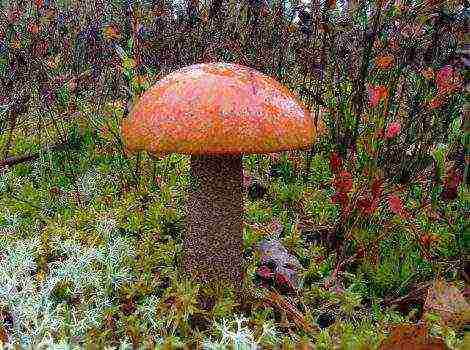Content

Walnuts
Krasnodar Territory is famous for its vineyards, amazing delicious vegetables and nuts. Local breeders have bred several varieties that are cold-resistant, productive and excellent in taste.
The choice of varieties of nuts growing on the territory of the Krasnodar Territory is very wide. What are the most popular, delicious and demanded varieties?
Yielding
One of the most popular is the Yielding walnut variety. The name speaks for itself. This plant produces an excellent harvest of tasty and nutritious fruits. Walnut seedlings in the Krasnodar Territory are very popular. After planting in open ground, the seedlings quickly take root, showing high resistance to diseases. Breeders note that the Urozhainy variety is practically not attacked by powdery mildew.
After planting seedlings in the ground, fruiting can be expected already in the fifth year of growth. The tree blooms from late April to mid-May. Full ripening of fruits occurs in the third decade of September. One adult tree of the Urozhainy variety gives from 24 to 28 kg of nuts. In this case, the weight of one nut reaches 8-10 grams. Fat content - 70%. Thanks to these qualities, this variety of nuts Yielding is very popular among gardeners for planting on personal plots.
Dawn of the East
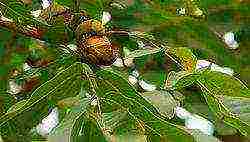
Walnut grade Zarya Vostoka
There are so many nuts growing in the Krasnodar Territory, and each variety has a high yield, resistance to diseases. Another favorite variety of walnuts, zoned in the Krasnodar Territory, is the Dawn of the East. Saplings take root well in the open field, after planting they begin to bear fruit in the fourth year. The tree blooms from late April to mid-May. Fruit ripening is simultaneous in late September and early October.
One healthy tree produces 24 to 28 kg of ripe, tasty and nutritious fruit. The technological indicators of the Zarya Vostoka variety are as follows:
- Fruit weight from 9 gr.
- Oil content - 65%.
- The shell thickness is less than one millimeter.
Breeder
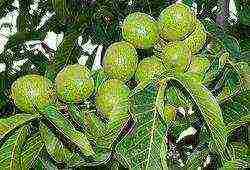
Nuts variety Breeder
Walnuts in the Krasnodar Territory grow in nurseries and personal plots. One of the novelties in breeding development is the Selector variety shown in the photo. Today, this variety is under the control of the State Variety Test. However, according to experts, this variety will be the best among all known. As observations show, the Selektsioner variety walnuts are distinguished by their increased resistance to diseases, pests, and frost. An adult tree begins to bear fruit in 4 years, yielding a crop of 25 kg.
The technological characteristics of the fruits are as follows:
- Oil content 72%.
- Weight - from 11 to 13 grams.
- The yield of a pure kernel is 56%.
Today, these are very high rates, allowing you to get a chic harvest of nutritious walnuts.
Aurora
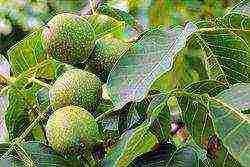
Aurora walnut
What other varieties of walnuts grow in nurseries in the Krasnodar Territory? A luxurious variety with a high yield - Aurora. Consumers have long appreciated the taste of the product. The first fruits can be obtained 5 years after planting. At this stage, the plant produces 10 to 12 kg of nuts. As they grow older, breeders collect more than 20 kg of nuts from one tree.
The fruits are distinguished by excellent taste, high oiliness.The shell of the Aurora variety is thin, which makes this variety popular among consumers. Aurora walnuts grown in nurseries in the Krasnodar Territory are recommended for use on large plantations intended for growing fruits for industrial use.
Five-year plan

Five-year plan
This is another variety that is currently undergoing state variety testing. Observations show that Pyatiletka walnuts are distinguished by high oil content and excellent taste. The tree is not whimsical, it shows resistance to various diseases. It tolerates frost well. The fruits reach absolute maturity at the end of September. This variety is recommended by breeders for widespread cultivation in the territory of the Kuban.
Note that nurseries in the Krasnodar Territory are engaged in the cultivation of various varieties of walnuts. Each of them is tested and officially evaluated by experts. Also on the territory of the region you can find wild varieties of nuts that grow in parks and squares of the region.
Thus
Krasnodar Territory is famous not only for excellent vegetables, temperate climate and hospitality of residents. This region is home to many varieties of nuts. Local breeders are professionally engaged in the cultivation and cultivation of new varieties of nuts, which are distinguished by excellent consumer properties. Thanks to this, nurseries in Krasnodar are popular with breeders throughout Russia.
Of the various cultivated varieties and forms of walnuts, preference should be given to winter-hardy, early-growing, high-yielding plants with high quality fruits. Also important factors are resistance to pests and diseases, its adaptability to local soil and climatic conditions. Walnut varieties, the descriptions of which will be given below, were developed by the North Caucasian Zonal Research Institute of Horticulture and Viticulture (Krasnodar). They are recommended for planting orchards of farms, peasant farms, as well as for planting in summer cottages in the Krasnodar Territory.
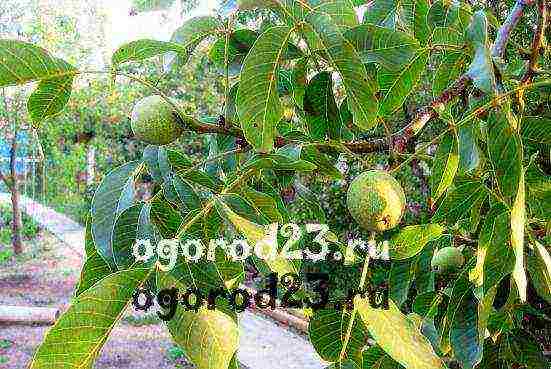
↑ to content ↑ Walnut variety Yielding
Zoned in the Krasnodar Territory. The tree is of moderate growth, quite winter-hardy, moderately resistant to brown spot (marsonia). Fast-growing. Fruiting occurs in the 4-5th year after planting. The type of fruiting is apical-lateral. Blooms - late April-early May. Nuts ripen in the second decade of September. The annual yields are high: 24-28 kg of dry walnuts are harvested from 12-year-old trees in the Krasnodar Territory. The average weight of one fruit is 8.7 g, the kernel yield is 51.8%, the fat content is 69.7%, the shell thickness is 1 mm.
Advantages: one of the best zoned walnut varieties for widespread cultivation, especially valuable for home gardening.
↑ to content ↑ Walnut variety Zarya Vostoka
Zoned in the Krasnodar Territory. Included in the State Register for the Russian Federation. The tree is of moderate growth, relatively winter hardy, moderately resistant to brown spot. The variety is early maturing. Begins to bear fruit from 4-5 years. The type of fruiting is apical-lateral. It blooms early - the third decade of April - early May, the fruits ripen together, but late - the end of September. Bears fruit regularly. The yield of 10-12 year old trees is high - 22-24 kg of dry walnuts. The fruits are medium-sized, the average weight of one is 9 g, the kernel yield is 55.4%, the oil content is 69.3%, the shell thickness is 0.9 mm. One of the best varieties for home gardening.
Advantages: valuable for its high, regular fruiting, suitable for widespread breeding.
↑ to content ↑ Walnut variety Breeder
It is under state variety testing. Variety of restrained growth, bears fruit annually, gives thin-peeled nuts. Relatively resistant to brown spotting. Winter hardiness of flower buds, wood is average. Fast-growing.Begins to bear fruit 4-5 years after planting. The type of fruiting is apical. It blooms in late April and early May, ripens in early September. Up to 16-20 kg of harvest is harvested from 8-10-year-old trees. Fruit weight - 11.6 g, kernel yield - 55%, oil content - 71.2%, shell thickness - 1.1 mm.
Advantages: It is a good variety for Kuban.
↑ to content ↑ Walnut variety Aurora
Zoned in the Krasnodar Territory. Included in the State Register of the Russian Federation for all zones of cultivation. The variety is vigorous, relatively winter-hardy, weakly affected by brown spot. Blooms - late April-early May. Fruiting occurs 4-5 years after planting, the yield rapidly increases over the years. The type of fruiting is apical-lateral, the yield of 10-12-year-old trees is 18-24 kg of dry walnuts. The fruits ripen in the third decade of September. Weight - 12.8 g, kernel yield - 54.8%, oil content - 68.8%, shell thickness - 0.9 mm.
Advantages: it is distinguished by good marketable, consumer qualities of fruits, regular annual fruiting, it is recommended for the establishment of industrial plantations.
↑ to content ↑ Walnut variety Five-year plan
It is under state variety testing. The variety is vigorous, fast-growing, with high field resistance to brown spotting, bears fruit regularly. Drought-resistant. Winter hardiness of flower buds, wood is above average. Blooms late - the first or second decade of May. Fruits appear 4-5 years after planting. The type of fruiting is apical-lateral. Up to 18-20 kg of harvest is harvested from 8-10-year-old trees. The fruits ripen in the third decade of September. Walnut mass - 9.1 g, kernel yield - 56.9%, oil content - 67.6%, shell thickness - 1.0 mm.
Advantages: It is a good variety for Kuban.
↑ to content ↑ Walnut variety Sovkhozny
The variety is vigorous, sufficiently winter-hardy, resistant to drought, slightly affected by pests and diseases. Begins to bear fruit 4-5 years after planting. The type of fruiting is apical-lateral. Blooms - late April-early May, fruits ripen in the third decade of September. Productivity - up to 17-22 kg of dry walnuts from a tree (age 10 years). Plants grow rapidly.
Fruits are medium and above average in size, weighing up to 10 g. They contain up to 54% of the kernel and up to 65% of fat. Walnut shell thickness is about 1 mm.
Advantages: has proven itself well in plantations and especially in home gardening.
↑ to content ↑ Walnut variety Pelan
Zoned in the North Caucasus region (Krasnodar Territory, Republic of Adygea). The variety is vigorous, fast-growing (yields fruits for 4-5 years), quite winter-hardy, drought-resistant, slightly affected by marsonia. The type of fruiting is apical-lateral. Blooms - late April-early May, fruits ripen in the third decade of September. The yield is good. regular (up to 20-24 kg of dry walnuts per tree).
Fruits are medium in size, average weight - 9.5 g (maximum - 10.5 g), kernel yield - 56.3%, oil content - 68.2%, shell thickness - 1 mm.
Advantages: one of the best Kuban varieties, suitable for widespread cultivation.
↑ to content ↑ Walnut variety Dessert
Zoned in the Krasnodar Territory. The tree is vigorous with a spreading, rounded-oval crown. The variety is fast-growing, drought-resistant, walnuts have an excellent presentation. A good ratio of protein to fat enhances the dessert quality of the kernel. Brown spot is weakly affected. Winter hardiness of flower buds, wood is not high enough. Blooms early - end of April. Fruiting occurs 4-5 years after planting. The type of fruiting is apical. On a good agricultural background, it bears fruit annually. Productivity - 20-22 kg per tree. The fruits ripen in the first or second decade of September. Walnut mass - 12.6 g, kernel yield - 47.5%, oil content - 69.3%, shell thickness - 1.0 mm.
Advantages: it is distinguished by its early maturity, early ripening of good quality fruits, it is recommended for widespread breeding, especially valuable for amateur gardening.
↑ to contents ↑ Walnut variety Petrosyan's Favorite
Zoned in the Krasnodar Territory. The tree is vigorous with a rounded-spherical crown. The variety is fast-growing, drought-resistant, gives products of high marketable, taste qualities. Winter hardiness of flower buds, wood is not high enough. Resistance to brown spot - medium. Blooms early - end of April. The variety is homogamous, that is, the flowering of male and female flowers occurs at the same time. Begins to bear fruit 4-5 years after planting. The type of fruiting is apical. The fruits ripen late - at the end of September. In a good agricultural background, it bears fruit regularly. Productivity - 20-22 kg per tree. Walnut mass - 11.8 g, kernel yield is high - 60.6%, oil content - 71.4%, shell thickness - 0.8 mm.
Advantages: belongs to the most valuable Kuban varieties, suitable for widespread cultivation, especially valuable for farm and home gardening.
↑ to contents ↑ Walnut variety Graceful
Zoned in the Krasnodar Territory. The tree is vigorous with a large wide-oval crown. The variety bears fruit regularly, is drought-resistant, slightly damaged by brown spot, gives products of high marketable and taste qualities. Winter hardiness of flower buds, wood is above average. Blooms early - end of April. Begins to bear fruit 5-6 years after planting. The type of fruiting is apical. The fruits ripen in the second decade of September. Productivity - 18-20 kg per tree. Walnut mass - 12.5 g, kernel yield - 54.1%, oil content - 67.6%, shell thickness - 1.2 mm.
Advantages: it is distinguished by high commercial qualities of fruits, it is recommended for the establishment of industrial plantations.
↑ to content ↑ Walnut variety Krasnodarets
It is under state variety testing. The tree is vigorous with a dense, wide-rounded crown; clarification is periodically required. The variety is of restrained growth, slightly damaged by brown spot, regularly bears fruit, gives walnuts of high marketable, taste qualities. Drought-resistant. Winter hardiness of flower buds, wood is average. Blooms early - mid-April-early May. Begins to bear fruit in the 4-5th year of life. The type of fruiting is apical-lateral.
The fruits ripen at the end of September. Productivity up to 18-20 kg of dry walnuts from a 10-year-old tree. Average weight - 12.7 g, kernel yield - 49.1%, oil content - 70.1%, shell thickness - 1.2 mm.
Advantages: very large, tasty fruits, especially valuable for home gardening.
Since ancient times, the walnut has been considered one of the most cultivated types of fruit trees. If we take the scale of the planet where the walnut grows, there are not so many areas and localities where this plant is cultivated and used for harvesting. The area of wild and cultural growth makes up a huge area of Eurasia: this is the north of China and India, Central Asia, in the south of Europe and in its central part. As for Western Europe, there are also conditions for cultivation, and a wild population, but its cultivation, gardens, and so on, practically did not receive any significant distribution. The cultivation of this fruitful tree in Iran and the USA is very strong.
The subtleties of growing walnuts in Russia, Ukraine and Belarus.
If we talk in more detail about where the walnut tree grows in Russia, then there will be something to tell about, since historically it happened that they love it here, and the cultivation of walnut orchards is not something out of the ordinary. The cultivation of walnuts in the middle lane is quite common and successful, but doing this business in the Krasnodar Territory, or, for example, in the Leningrad Region, Moscow and the Moscow Region, are two big differences.Due to the properties of the soil and the peculiarities of the climate, it is naturally more convenient and ultimately more profitable to plant gardens to the south, however, landing in the Leningrad and Moscow regions or in Belarus - can also be fully justified... If specifically in Leningrad and neighboring latitudes, then, due to climatic conditions, the cultivation of walnuts will already be difficult: the harvest will not be every year, and the trees will not develop to full growth. Also, there is a risk of freezing of the seedling, since lingering temperatures below -280C, it does not withstand.
The most successful, in comparison with growing in central Russia, is its cultivation in the southern regions. Walnuts grow well in the Crimea, or the same Krasnodar Territory. Climatic features and soil conditions make it possible to grow them without any problems on the scale of industrial and semi-industrial cultivation, getting good yields every year.
As in any other business, in matters of growing walnuts in the middle lane, there are nuances and subtleties that we will try to consider and systematize. The walnut tree is grown in Moscow and the Moscow region, it's real. You just need to minimize the risks as much as possible, or better, just remove them.
Based on the conditions and genetics of seedlings, it should be borne in mind that planting and growing walnuts in Russia or planting walnuts in Belarus and Ukraine will involve the fulfillment of a number of requirements and conditions. Where to begin? Everything is logical and traditional:
- Planting a seedling;
- Watering and feeding;
- Crown formation and pruning.
Planting a seedling, features
Of course, all the activity begins with the determination of the landing site! Our tree is very demanding for light and heat, one might even say - capricious. Somewhere in the "south", where it is warm all year round, you can not really "bother", as there is plenty of heat and sun there. But, when planting a garden in the middle lane, you will have to carefully choose an even, non-shaded place for these purposes. Low-lying areas should be avoided, and it is preferable (one might even say ideally) to land in an open area that has protection from the wind. As an option: if there is a wall of a building or a fence, then trees can be planted on its southern side. Also, do not forget that it is better to plant the nut at a distance from other trees, as it will suppress their development and ultimately they will disappear.
Watering and feeding
Also, you should pay close attention to watering and feeding. These two important factors greatly influence the growth rate of the seedlings and the formation of a normal, healthy fruit-bearing tree. Regular feeding of walnuts can be described something like this:
- annually - with nitrogen fertilizers in the spring;
- 3-7 waterings per year for a young seedling (depending on the amount of precipitation in the region);
- and once every 2-3 years - organic matter, phosphorus and potash fertilizers in the fall.
The soil around the root system and trunk must be mulched. The practice of gardeners shows that this will greatly facilitate the further care of the tree. The cultivation of walnuts in Belarus is associated with the peculiarities of the soil, there it is necessary to additionally introduce calcium as complementary food in order to compensate for its lack in the soil.
Crown formation and pruning
The next important nuance is shaping and pruning. The tree grows in Belarus, Ukraine and central Russia quite successfully, provided that there is enough light for it. Compared to a wild tree, a properly shaped tree, thanks to sufficient sunshine, develops much, simply and many times better, and then bears fruit.
Crown formation methods can be different. A separate section on the All Agro website is devoted to this.
An adult tree must be thinned regularly for an already formed crown, about once every 2-3 years, in order to ensure the most uniform access of all leaves to sunlight. In mid-latitudes, heat and sun issues play a significant role., therefore, it is necessary to take a particularly responsible approach to this particular task.
Walnut varieties for the middle zone (Russia, Ukraine and Belarus)
Many decades of the practice of growing walnuts on the scale of industrial cultivation, of course, gave rise to a certain number of varieties that are most adapted to certain conditions. Walnut varieties for Moscow and the Moscow region, the Leningrad region and Krasnodar region, the variety for the south and middle lane or Ukraine may be different.
If we talk about the Crimea or the Caucasus, then these are the boundaries of the natural growth of this species. Almost all existing varieties are suitable for these regions. It makes no sense to endow them with any special properties in terms of stability and so on, there are no climatic restrictions ... This also applies to walnut varieties for the Krasnodar Territory. It is not surprising that there are many of them and, as a rule, they are united by one drawback - the lack of resistance to severe and prolonged frosts. You can list such names of varieties for cultivation in the south, such as Zarya Vostoka, Pyatiletka, Dessertny, Graceful, Krasnodarets, Pelan, most varieties of Ukrainian and Moldovan selection. Their advantages include remarkable fertility, tasty and large nuts and excellent adaptability to the characteristics of the soil composition and resistance to certain kinds of pests.
As practice shows, most likely, the best variety for Crimea is Juglandeae angulosa. It is a medium-sized hard shell nut. It is a natural variety for this region, which also grows very well throughout the southern part of Russia. The main advantages include its high yield: for over 40 years, such a tree bears excellent fruit with high-quality and tasty fruits. In general, we can say about him that this is an excellent walnut variety for the south and central zone of Russia.
Walnut varieties in Belarus are not much different from those for the middle zone of the Russian Federation or Ukraine, we can, with a certain degree of error, combine them into one group. Of these, it is worth highlighting such varieties as Chernovetsky-1, Bukovinsky-1, Aurora, Zarya Vostoka, Urozhainy and Giant. These are very popular varieties of walnuts for Ukraine, they are one of the most popular varieties for the Russian Federation and Belarus, they are well suited for industrial cultivation in the southern regions, for example, for the Crimea. They are one of the leaders in frost resistance, early maturity, have a high yield, and give quite large and very tasty fruits.
Outcomes
As follows from the above, the cultivation and cultivation of walnuts has its own specifics and differs by region. For successful walnut farming, you definitely need to pay attention to them, and the result will not be long in coming. And the many years of work of breeders, materialized in the form of early-growing varieties, will make this task even easier!
You can find out more about the varieties of walnut varieties for different growing areas. here.
Where does the walnut grow
5
(100%)
1
once voted
For those who plan to cultivate walnuts on their plot in a vegetable garden or garden, it is important to familiarize themselves not only with the rules of care. It is advisable, before the trees enter the fruiting stage, to find out how to properly collect walnuts and when to start this procedure. You will also learn where the yield of nuts is greater in Russia and how to determine the signs of maturity for harvesting.
When nuts are harvested: signs of ripeness
 When walnuts are harvested
When walnuts are harvested
Knowing in which month a walnut is harvested when grown in a particular region allows the grower to get the most ripe walnuts at the lowest cost. The volume of the harvest is negatively reflected by the fact that birds and squirrels are very fond of eating them.And they know exactly when and where to collect walnuts with excellent taste. The fruits removed from trees at the right time have many useful properties that remain in them for one to two years when placed in favorable conditions.
What they look for when picking nuts:
- One of the most noticeable signs is cracking of the soft amniotic membrane. More favorable conditions for ripening reign on the lower branches, where the first ripe fruits are located.
- The foliage of a tree with ripening nuts dulls and turns yellow.
- It is easy to determine the approximate harvest time by knowing the variety. The technical characteristics also indicate the yield of walnuts from one tree.
- As a rule, the fruits of trees that bloom in spring reach maturity in August-September, and blooming in June - from the third week of September.
- Mature nuts develop a hard shell, the kernel under which remains moist, which makes it feel heavy.
What month is the walnut harvested?
Experienced gardeners sometimes begin peeling nuts before their shell cracks, counting. This is done, as a rule, from the last week of August to the third week of September. To do this, green nuts are simply hammered from a tree with a stick, collected and packaged in wooden boxes. Ripening of fruits occurs already in this form for two to three weeks in a cool place.
Many people, when picking nuts using this system, proceed from the opinion that it is more reliable to harvest earlier than to overexpose and suffer losses due to birds and rodents. After ripening in boxes, the fruits must be dried with high quality so that they can be stored for more than one year.
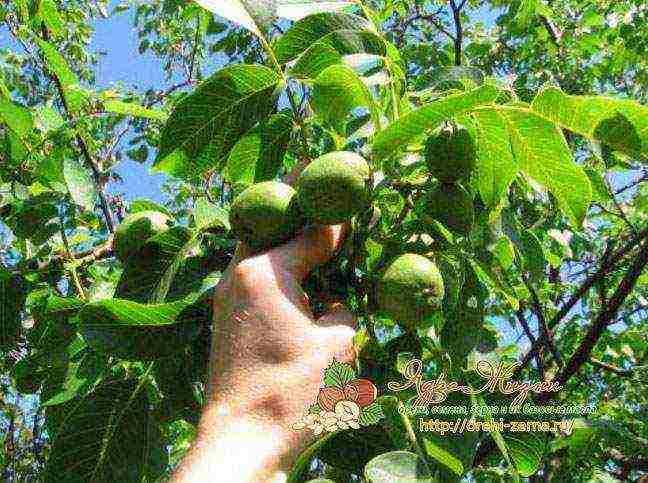 What month are walnuts harvested?
What month are walnuts harvested?
Somewhat later, walnuts are harvested in Krasnodar. The fact is that most varieties suitable for the local climate do not reach maturity until mid-September. Despite the late harvest, the volume and average nut size in this southern region is very impressive. Some locals know where to pick walnuts in Krasnodar, and go to the forest belts in early autumn. Here the plant is well distributed in its natural form. Those who have time to collect the wild harvest first get a few sacks of nuts for the winter.
How to properly collect walnuts
Without knocking off the branches, the collection of walnuts is carried out not in one or two days, often this procedure is delayed for weeks, since the fruits fall off gradually as ripeness is reached. First of all, you should know that nuts that have fallen to the ground must be collected within 24 hours. After that, they must be cleaned of dirt and sent to dry. Nuts that have lain in the ground for several days are unsuitable for storage, since they are more likely to become infected with mold.
Unshot bared nuts or with a tight-fitting and intact shell are knocked down with a stick and poured into buckets or boxes for ripening. They should be kept separate from those that fell from the tree themselves. Those gardeners, from whose trees all the fruits are easily knocked off, can harvest the entire crop in a day, sorting it for ripening and drying.
Nuts with cracked shells that are still sticking to the branches can be removed by shaking the branches. True, this method is most useful when growing those varieties with a slight drop in yield.
In order not to damage the soft shell of the fruit during a fall, gardeners use a special tool that can be made without difficulty on their own. It is a long stick with a bag. Such a device makes it possible to pick nuts from the ground.
When walnut leaves are harvested
The chemical composition of the foliage of walnut trees makes them a source of many biologically active substances. Thanks to them, the medicinal use of greens helps in the treatment of many diseases, strengthening the immune system, and increasing the general tone.The greatest concentration of useful components in greens is observed at the turn of spring and summer. This is especially noticeable in the strong balsamic scent. Therefore, collecting medicinal raw materials for future treatment should be at this time.
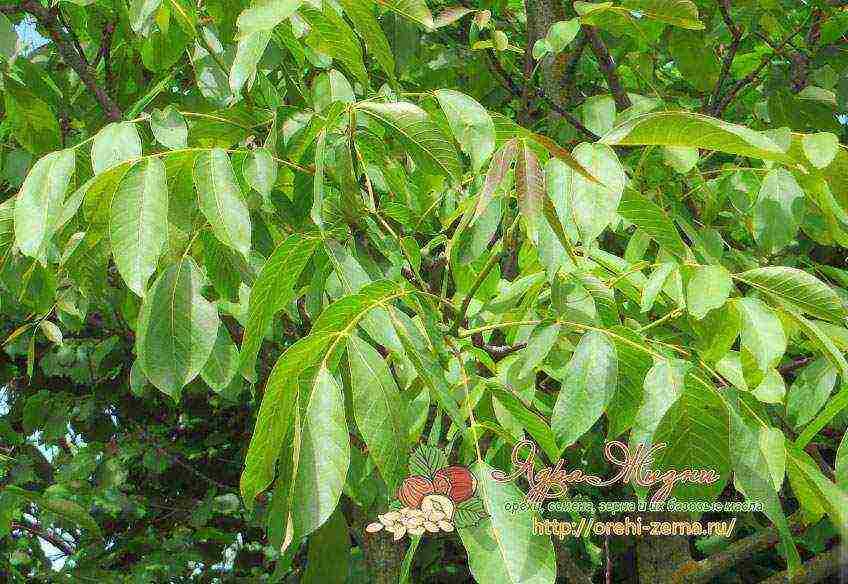 Walnut tree leaves
Walnut tree leaves
Where to collect walnuts in Crimea
In ancient times, the walnut was brought to the territory of Crimea by the Greeks, but the plant liked the local climate. Now this tree grows as a full-fledged heir to the range. At the turn of the 19th-20th centuries, Crimea was one of the largest walnut-producing regions, but by the middle of the last century it had lost this status.
Nevertheless, the tree today grows freely throughout the entire territory of the peninsula. In general, it can be collected almost anywhere. The main thing is to choose the right moment so that the fruits are ripe and healthy.
Find out the best ways to wash your hands of green nut peels
How to store harvested walnuts
After harvesting, the nuts are dried for long-term preservation of the useful composition. For this, 5-6 days of drying is carried out on a litter. It is advisable to do this outdoors, but if this is not possible, a home floor will do.

For effective storage for more than six months, you need to dry the walnut in a warm oven for 50-60 minutes. The temperature needs to be low, so you can slightly open the oven door.
After good drying, the nuts should be poured into boxes or cloth bags and placed in a dry place without a lot of light with an ambient temperature of about 15˚C. A balcony is not a suitable storage space at all. There is often high humidity on it, due to which the nut is attacked by mold. The risk of infection increases significantly when the air humidity is over 70%. High temperature and lots of light also do not contribute to long-term storage. From this, fatty acids are oxidized, and the product acquires a rancid taste.
How to store peeled kernels
Kernels devoid of shell protection have a much shorter shelf life. The maximum preservation of useful properties can be achieved in the refrigerator by putting a tightly closed glass jar with peeled nuts there. So they can stay in their best form for at least six months.
To disinfect the kernels, it is also recommended to bake them in the oven at a low temperature. It is important that oil does not leak from the product during this procedure. Otherwise, the nuts will taste bitter.
Try making delicious green nut jam


